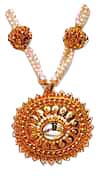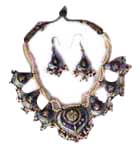|
Rajasthan
became famous for its jewelry industry from very early times, being
an important source of precious and semiprecious stones. Sophisticated
jewelry, set with precious stones using the kundankari technique
or decorated with bright enamel work, known as minakari, were made
for these Rajput court and affluent people. Skillful artisans from
Lahore, Delhi, Gujarat and Bengal, attracted by the liberal patronage
of the Rajas, came to work in Jaipur, Bikaner, Udaipur and Jodhpur.
Throne Silver was used extensively in the court to make Cradles,
Carriages, Howrahs, Utensils, Door Panels and Thrones. The lion
motif, could only be used for the throne or other formal furniture
of the ruler. Various Techniques of Jewelry Making.
|
Enameling
- A lithograph of 1884 showing a typical
workshop of a monikar. While three young assistant shape the
ornaments and engrave the design on it, the old master craftsman
carefully fires it in the earthen bhatti (kiln) fired with
charcoal. The process is not much different today.
|
|
|
|
Minakari -
Enameling or Minakari, is not indigenous to Rajasthan. It
was introduced at the turn of the 16th century by Raja Man
Singh of Amber. He is said to have brought five skillful enamelers
from Lahore where the craft had flourished under the Mughals.
They settled in Jaipur and created fascinating types of jewelry
and decorative pieces with exquisite enameling work in brilliant
colors, such as this beautiful goblets and this necklace.
|
|
Kundankari Technique - The
Jaipur lapidary displays superior skill in carving from hard
stones such as jade, rock crystal, agate, garnet, emerald,
topaz, amethyst and spinal. The Jadiyas(stonesetters) create
fabulous pieces of jewelry using the age-old kundankari technique.
In this typically Indian technique, the gemstones are set
within solid walls of gold. Types of Jewelry.
|
|
|
|
|
Tribal Jewelry -
The ornaments of Barmer, Bhilwara and of the Meos of
Alwar follow age-old designs typical of a particular
tribe. The design often mimic the shapes of leaves,
tendrils and flower buds, finished with a classical
simplicity.
|
|
|
Turban Jewels - Following
the Mughal emperors, the Rajput rulers wore costly turban
ornaments, jigha, made of dazzling, enameled gold and set
with rare rose-cut diamonds, rubies, emeralds, sapphires and
pearls turban jewels like this one are still made by the jewelers
of Jaipur. The sarpati, made of enameled gold, is tied around
the turban on formal occasions. The reverse of this piece
is beautiful enameled in white, red and green.
|
 |
|
|
Body
Jewelry - Women wear jewelry
on many parts of their body. Personal ornaments include specific
type worn on the Feet, head, forehead, ear, nose, neck, chest,
arm, wrist, fingers and waist. Nose rings are attached to
the earrings by fine gold chains and globular pendants are
worn on the foreheads.
|
Village
Goldsmith - In every small town
or village, the resident sunar(Goldsmith) produces traditionally
designed ornaments to meet the needs of the tribes living in the
surrounding areas and those of the ordinary village folk. He also
works as the repair expert, money lender and pawnbroker.
Manufactures
List : Visit
Our Manufactures List Section
|
Natural
Ecosystems
| Agriculture
| Religion
|
| Art & Crafts |
Folk Dances |
Instruments
| Costumes
|
| Cuisine
| Maps
| Palace
On Wheel | Adventure
Tourism | Specialties
|
|





